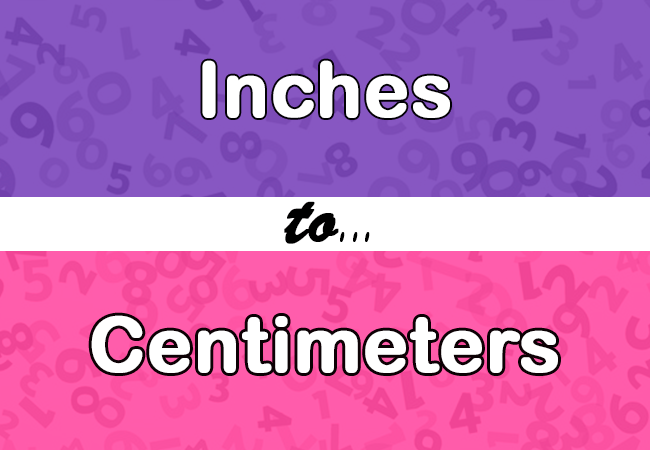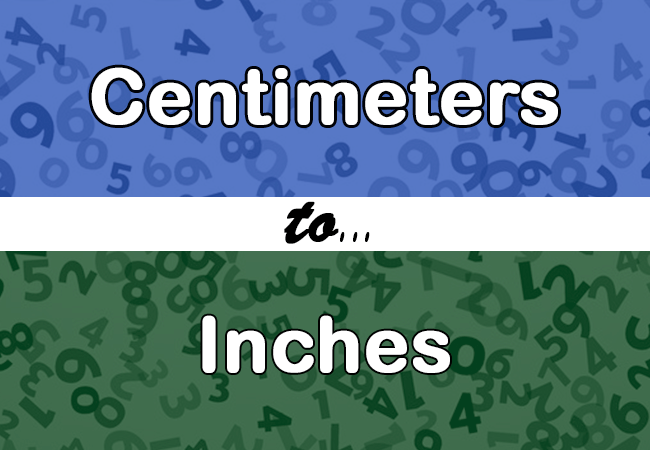All conversions from 1 to 10,000
Frequent conversions
| Length | Equivalence |
|---|---|
| 1 millimeter (mm) | 0.1 centimeters (cm) |
| 1 centimeter (cm) | 10 millimeters (mm) |
| 1 inch (in) | 2.54 centimeters (cm) |
| 1 foot (ft) | 12 inches (in) |
| 1 yard (yd) | 3 feet (ft) |
| 1 meter (m) | 100 centimeters (cm) |
| 1 kilometer (km) | 1000 meters (m) |
Hot to convert Inches to Centimeters
- Determine the number of inches you want to convert. For example, if you want to convert 6 inches, then you must use the number 6 as the number of inches to convert.
- Use the conversion formula. The formula for converting inches to centimeters is as follows: centimeters = inches * 2.54. Therefore, to convert 6 inches to centimeters, you must multiply 6 by 2.54.
- Perform the calculation. When you multiply 6 by 2.54, you get the result of 15.24. This is the number of centimeters that correspond to 6 inches.
- Round the result, if necessary. If you want to get a more accurate result, you can round the result obtained to a number with a certain number of decimal places. For example, if you want to round the result to two decimal places, then you should get 15.24 centimeters.
- Write down the result. Once you have performed the calculation and rounded the result, you should write down the number of centimeters obtained. In this case, the result is 15.24 centimeters.
Examples of measurements
- The size of a TV or computer monitor is often measured in inches. For example, a 32-inch TV has a screen that is 32 inches in size.
- The width of a book or magazine is also often measured in inches. For example, a book that is 8 inches wide is 8 inches in width.
- The size of a bed is often measured in inches. For example, a twin-size bed is typically 75 inches long and 38 inches wide.
- The size of a suitcase is also often measured in inches. For example, a suitcase that is 22 inches long, 14 inches wide, and 9 inches deep is 22 inches long, 14 inches wide, and 9 inches deep.
- The size of a door is often measured in inches. For example, a standard interior door is typically 80 inches tall and 36 inches wide.
Other frequent conversions
| Inches | Inches |
|---|---|
| 1 | 1000 |
| 2 | 2000 |
| 3 | 3000 |
| 4 | 4000 |
| 5 | 5000 |
| 6 | 6000 |
| 7 | 7000 |
| 8 | 8000 |
| 9 | 9000 |
| 10 | 10000 |
What is an Inch?
An inch is a unit of length measurement used primarily in the imperial and U.S. systems of measurement. The word “inch” comes from the Latin “uncia”, meaning “a part of a pound”. Although the inch has long been used in different countries and measurement systems, its definition and size have changed over time.
Imperial System
In the imperial system, one inch equals 2.54 centimeters. This means that 12 inches equals 1 foot, and 3 feet equals 1 yard. The imperial system is used mainly in the United Kingdom and some other countries, and is maintained for historical and cultural reasons.
U.S. System
In the U.S. system, one inch equals 2.54 centimeters, as in the imperial system. However, the U.S. system also uses a different inch, known as the “U.S. inch,” which is slightly smaller than the imperial system inch. The U.S. inch is equal to 2.54 centimeters minus one thousandth of an inch, which means it is slightly smaller than the imperial system’s inch. Although the U.S. system and the imperial system use the same word for inch, there is a slight difference in its size.
History of the Inch
The size of the inch has changed over time. In the Roman system, an inch was equal to the length of the thumbnail. In the Old English system, one inch was equal to the length of three barley seeds placed side by side. As technology and the ability to measure accurately increased, the inch became more precisely defined. Today, a standard steel ruler is used to define the inch and ensure that all measurements are accurate.
Uses of the Inch
The inch is often used to measure the length of small objects or to measure short distances. For example, it is used to measure the length of a book or the width of a table. It is also used to measure the length of television or computer screens, as well as the height of doors or the size of beds. In addition, it is used to measure the width of automobile tires or the depth of a suitcase.
Accuracy of the Inch
Although the inch is a commonly used unit of measurement, it is important to note that it is not the most accurate unit of measurement. In some cases, more precise units of measurement, such as the millimeter or micrometer, may be used to measure very short distances or to measure accurately in the field of science or engineering.
Metric System vs. Imperial and U.S. Systems
Although the inch has been used for a long time, there is debate as to whether it should remain the primary unit of measurement used in the imperial and U.S. systems. Some people argue that the metric system, which is the system of measurement used in most countries in the world and is based on the meter and gram as the basic units of measurement, should be adopted. Others argue that the imperial system and the U.S. system are fundamental measurement systems that should be maintained for historical and cultural reasons.
In conclusion, the inch is a unit of length measurement used primarily in the imperial system and the U.S. system. Although its size has changed over time, it is currently defined as equal to 2.54 centimeters. It is used to measure the length of small objects or to measure short distances, and is commonly used in everyday life. However, in some cases, more precise units of measurement can be used to measure more accurately.
Importance of the Inch in Various Industries
Despite the ongoing debate over the use of the inch as a unit of measurement, it is important to note that it is still widely used in many fields and industries. For example, the inch is commonly used in the construction and manufacturing industries to measure the size and dimensions of building materials and finished products. It is also used in the retail industry to measure clothing sizes and in the automotive industry to measure tire sizes. In these and many other cases, the inch remains an important unit of measurement that is used to ensure accuracy and precision in a variety of applications.


